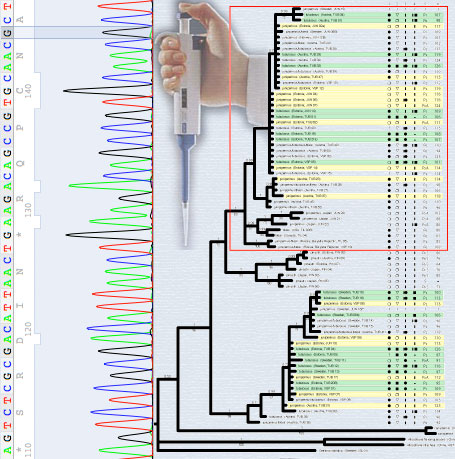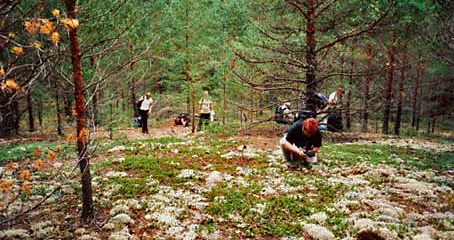

Systematics and Phylogeny
The purpose of the research on systematics and phylogeny is to "improve" the current biological system – to find out the species that are phylogenetically related and to assign them to the same genus, but also to find ways how to delimit different genera more evenly. For this we use different methods of analyzing molecular characters, and also evaluate morphological and chemical traits. Currently we study the lichens from the family Parmeliaceae. It is the biggest family among lichenized fungi, including about 80 genera and 2700 species. Specifying species phylogeny serves two purposes: firstly, it contributes to the theoretical knowledge about speciation and species relationships; secondly, phylogenetical delimitation of taxa helps us to assess more accurately various qualities of species, their distribution, bioindicative potential, vulnerability etc. The following persons in our team study lichen systematics and phylogeny: Tiina Randlane, Andres Saag, Lauri Saag, Tiiu Tõrra and Kristiina Mark.
Ecology
Our group's ecological studies deal with species richness and composition but also factors affecting these in different forest types, wooded meadows and on alvars. We evaluate the importance of different substrate qualities (e.g. bark pH, tree circumference, lighting) and forest community characters (e.g. forest stand´s age, location) as the influencing factors of lichen species richness and composition. We are also researching
lichens bioindicative values related to air pollution and forest continuity. People studying Lichen Ecology are: Inga Jüriado, Liis Marmor and Ede Leppik.
Floristics and Conservation
UT Lichen Team is consistently studying and ascertaining the Estonian lichenoflora species list. The results of this work are updated once a year. Currently the checklist of Estonian lichenoflora consists of 1132 species, of which 926 are lichenized fungi (lichens), 176 lichenicolous fungi, and 30 species of saprotrophic fungi systematically close to lichens. We also gather data about species distribution and habitat to help us evaluate species endangerment, need for protection and conservation methods. On the proposal of our workgroup, 51 lichen species were taken under protection of state law in 2004. In 2008 we prepared the lichens part for the Estonian Red List of Threatened Species.
listMain topicsteemad-enteemad-en5urlInformation system of lichenseseis-eneSEIShttp://www.eseis.ut.ee/index_en.htmleSEISurlTeachers, researches and technical staffinimesed-I-enPeople - staff/groups/en/search/?sort=title&kind=wiki&sortDirection=forward&tag=staffPeople - staffurlPh.D. and Master Studentsinimesed-II-enPeople - post-graduates/groups/en/search/?sort=title&kind=wiki&sortDirection=forward&tag=post-graduatesPeople - post-graduatesurlResearch and applied activities; projectsteadus-enResearch/groups/en/search/?sort=title&kind=wiki&sortDirection=forward&tag=researchResearchurlResearch and teaching; research themes for studentsope-enEducation/groups/en/search/?sort=title&kind=wiki&sortDirection=forward&tag=researchEducation/groups/en/search/index.rss?sort=createdDate&kind=weblog&sortDirection=reverselist/groups/en/search/?sort=createdDate&kind=weblog&sortDirection=reverseBlogBlog-enBlog-en?sort=createdDate&kind=weblog&sortDirection=reverse0/groups/en/sidebar/Blog-encreatedDateweblog3Blog-enreverseBlogsearchsearch/groups/en/search/index.rss?sort=modifiedDate&kind=wiki&kind=weblog&kind=mailinglist&sortDirection=reverselist/groups/en/search/?sort=modifiedDate&kind=wiki&kind=weblog&kind=mailinglist&sortDirection=reverseRecent ChangesRecentAddsList-enRecentAddsList-en?sort=modifiedDate&kind=wiki&kind=weblog&kind=mailinglist&sortDirection=reverse0/groups/en/sidebar/RecentAddsList-enmodifiedDatewikiweblogmailinglist3RecentAddsList-enreverseRecent Changessearchsearch
Comments